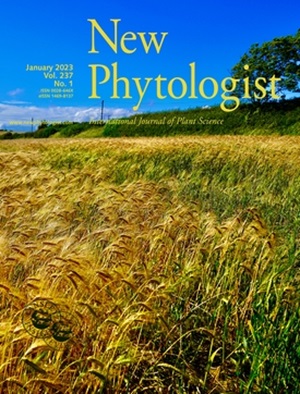The E3 ubiquitin ligase BRG3 and the protein kinase MPK7 antagonistically regulate LBD36 turnover, a key node for integrating nitrate and gibberellin signaling in apple
IF 8.3
1区 生物学
Q1 PLANT SCIENCES
引用次数: 0
Abstract
- Nitrate is the main source of nitrogen in plants. Nitrate stimulation causes changes in plant secondary metabolites, including anthocyanins. However, the molecular mechanism underlying how nitrate regulates anthocyanin biosynthesis remains unclear. In this study, we identified a nitrate response factor MdLBD36 in apple. This factor positively regulated nitrate deficiency-induced anthocyanin biosynthesis by promoting the transcriptional activity of MdABI5, an important regulator of anthocyanins, and directly activated MdABI5 expression.
- The E3 ubiquitin ligase MdBRG3 promoted the ubiquitinated degradation of MdLBD36 to reduce anthocyanin biosynthesis under nitrate-sufficient conditions. Nitrate deficiency-activated MdMPK7 maintained the stimulating effect of MdLBD36 on anthocyanin biosynthesis by counteracting the MdBRG3-mediated degradation of MdLBD36.
- Nitrate coordinated gibberellin (GA) signaling to regulate anthocyanin biosynthesis. The GA signaling repressor MdRGL2a contributed to MdLBD36-promoted anthocyanin biosynthesis by enhancing the MdLBD36–MdABI5 interaction and increasing the MdLBD36 transcriptional activation of MdABI5.
- In summary, our results elucidate the molecular framework of the coordinated regulation of the nitrate signaling response and anthocyanin biosynthesis by ubiquitination and phosphorylation. This study revealed the cross talk between nitrate and GA signaling in the regulation of anthocyanin biosynthesis and provides references for an in-depth exploration of the nitrate signal transduction pathway and its interactions with hormones.
求助全文
约1分钟内获得全文
求助全文
来源期刊

New Phytologist
生物-植物科学
自引率
5.30%
发文量
728
期刊介绍:
New Phytologist is an international electronic journal published 24 times a year. It is owned by the New Phytologist Foundation, a non-profit-making charitable organization dedicated to promoting plant science. The journal publishes excellent, novel, rigorous, and timely research and scholarship in plant science and its applications. The articles cover topics in five sections: Physiology & Development, Environment, Interaction, Evolution, and Transformative Plant Biotechnology. These sections encompass intracellular processes, global environmental change, and encourage cross-disciplinary approaches. The journal recognizes the use of techniques from molecular and cell biology, functional genomics, modeling, and system-based approaches in plant science. Abstracting and Indexing Information for New Phytologist includes Academic Search, AgBiotech News & Information, Agroforestry Abstracts, Biochemistry & Biophysics Citation Index, Botanical Pesticides, CAB Abstracts®, Environment Index, Global Health, and Plant Breeding Abstracts, and others.
 求助内容:
求助内容: 应助结果提醒方式:
应助结果提醒方式:


